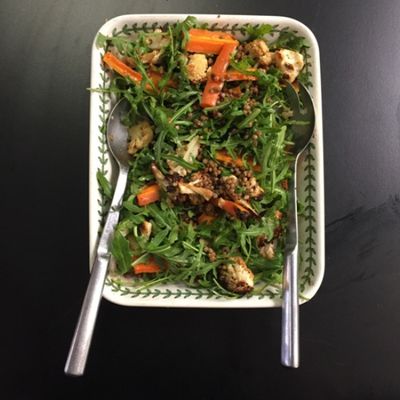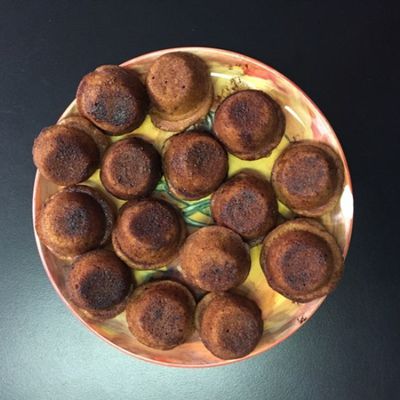Earlier this week we roadtested six different recipes from Grown & Gathered – a gorgeous new how-to book from Matt and Lentil Pubrick all about growing, gathering, nurturing and cooking your own food. Matt and Lentil came by to share our dishes with us, and select the best one. Here are the results…

Stella Charls made Caponata (pg. 284):
I love chopping fresh tomatoes. It makes me feel like I’m part of an extended Italian family because as I chop I sing along to ‘Tintarella di Luna’ imagining I’m a part of this scene from the Looking for Alibrandi film adaptation. And to make the Grown & Gathered caponata I got to chop a lot of fresh tomatoes, which made me very happy. Plus, caponata is simple and tasty and combines a few of my favourite things (eggplant! olives! basil!). This dish might even be the easiest one in Grown & Gathered plus it tasted great. Sure to be a regular in my kitchen from now on, served with pasta, farro, couscous or just in a bowl with some bread on the side. The only thing is, I used tomatoes from the greengrocer rather than growing my own (sorry Matt and Lentil!) – a summer challenge, perhaps?

Anthony Shaw made Pâté (pg. 272) and Sweet Potato & Almond Breakfast Bread (pg. 265):
Choosing one recipe to cook in Grown & Gathered was too difficult for me, so chose to do two.
The breakfast bread was so simple to make and really tasty. I quite literally threw everything into the mixer, poured it into a loaf tin, then stirred through the sweet potato puree. What could be simpler? Not sure if it was my quirky oven but it did take 15 minutes longer than the recipe. You could easily swap banana for the sweet potato, if you had some squishy bananas you wanted to use up and it would be just as good.
Making pâté always looks more difficult and impressive for something so easy. I really like Lentil and Matt’s recipe, however I did need to change it slightly. I used brandy instead of port or sherry, plus five ground cloves and a liberal teaspoon of cinnamon rather than the ground allspice berries. I also didn’t worry about the soaking of the livers as I don’t think it applies to chicken or duck livers. (If I was using kangaroo livers I would be sure to purge them for the eight hours as suggested.) The result was a buttery, rich and earthy flavour. When next I come across roo liver, I’ll be making the pâté with them.

Chris Gordon made Mustard, carrots, cauliflower & lentils (pg. 297):
This is super easy dish to make and I can now also tell you that it tastes pretty darn good too. Once you have made the mustard dressing with all its honey, seeds and oil (a delicious concoction that I will be using again for other dishes as well as this one), you spread it through the chopped veggies. Afterwards, you’ll need to give your hands a very thorough rinse because the concoction isn’t just delicious, but also very sticky and may just want to spread right over your whole kitchen. I love that this recipe is at heart – a no-nonsense serving of veggies with a sweet lemon kick. All of your food needs met in one dish, almost… Now, where’s the chocolate…?

Lian Hingee made Mixed grain & spout pilaf (pg. 294):
I was surprised by how easy this dish was, and relieved too as I made it really late in the evening. It took almost no time to prepare and throw together – though admittedly I cheated a little by buying pre-sprouted grains at the supermarket, and by cooking the brown rice and quinoa in a rice cooker. The result was a fresh dish with delicate flavours and good texture. Next time I made it I’m planning to add a bit more mint because I really loved the lift it gave the grains.

Jan Lockwood made Roast beetroot & lemon dip (pg. 269):
I was so happy to see a beetroot recipe in the book as I love the colour as much as the flavour. We also happened to have a surplus of beetroot growing in our home – thanks to my husband who is the gardener – and I was able to gather pretty much the whole kilo required for this recipe from our own backyard. We also already had lemons from a work colleague, as well as all the spices (coriander seeds, ground cinnamon, sweet paprika, salt) and the oil in the pantry, so I only had to source a few additional items (walnuts, natural yoghurt, garlic) and I was set to go. Preparation couldn’t have been easier: a little chopping of beetroot and lemon, peeling of garlic. Then it was a case of tossing the vegetables, oil and spices into the oven and leaving to roast. Some of my beetroot pieces were a little large so I took an extra 10 minutes. I enjoyed being able to just throw everything into the blender and blitz it.
I tasted it straight away (just for seasoning purposes, of course) and found it was delightful when still warm. So having stored it in the fridge overnight at home and again in the morning today I decided to give it a brief warm through in the microwave to get the flavours singing out again. It’s not as smooth as some dips, due to the crunchy walnuts, but I think that makes it very versatile. I tried it with celery crudités as well as fresh baguette and I reckon it will work really well with cheese. It’s a winner!

Bronte Coates made Soured wholegrain doughnuts (pg. 351):
Making ‘doughnuts’ by baking them in mini muffin trays does sound counter-intuitive but here’s a recipe that changed my mind! This was an easy one to make, the only hitch being that you need to let the mixture sit for 6-12 hours first for the ‘souring’ – so you do need to plan ahead. (I made my mixture in the morning before I left for work.) The best part of the process was that my entire house smelt like doughnuts for hours, and I also loved how springy the final result was. If you really are a doughnut purist, it may set your mind at ease to consider these to be ‘doughnut flavoured mini muffins’ instead. Either way, they’re tasty and healthy and an excellent sweet treat for parties.
And the winners are…
ROAST BEETROOT & LEMON DIP (Matt’s pick)
PÂTÉ (Lentil’s pick)


